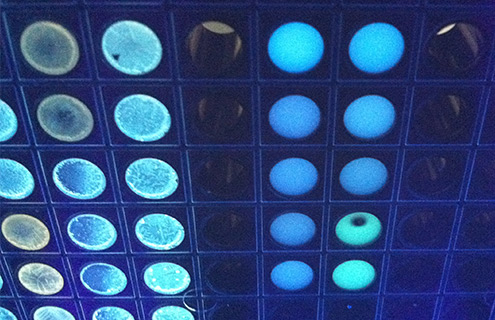Reporter-labeled bacterial strains have many applications in the basic and applied sciences. In microbiological research, reporter systems assist in the study and analysis of gene expression, protein-protein interactions, microbial quantification and detection, host-pathogen interactions, drug discovery, and food testing. As a result, these transgenic microorganisms have considerably enhanced our knowledge of microbial transcriptomics, proteomics, and pathogenesis, with significant implications in the development and evaluation of novel therapeutics and quality control assays.
Implementing a reporter system, however, can be challenging and time consuming with regard to cloning procedures, transformation protocols, microbial growth requirements, and construct validation. That’s why ATCC has developed and successfully transformed expression vectors harboring either GFP or luciferase reporter genes into a variety of authenticated bacterial strains. Each of these strains has been thoroughly examined for reporter expression, vector stability, and compatibility with various fluorescence or luminescence detection technologies. Moreover, each strain is easily quantifiable and exhibits consistent growth rates and fitness trends as compared to the parent strain.
But don’t just take our word for it—see for yourself! Explore our collection of reporter-labeled bacteria today.
Watch our webinar to see how reporter-labeled microbial strains can illuminate your research
Research tools

Reporter-labeled Strains: Powerful Tools for Microbiology Research
Reporter-labeled strains provide a unique tool for analyzing the invasion, colonization, localization, and pathogen load of specific species within host cells or tissues under different physiological conditions or stages in the infection cycle. Moreover, the ability to easily visualize and quantify microbial strains allows for an efficient and reliable mechanism to quickly screen a large number of novel antimicrobial therapies. Read this white paper to learn more about the common reporters used in microbiological research and the various applications of reporter-labeled strains.
Read the White Paper
Novel Fluorescent Reporters for Studying Host-pathogen Interactions
We have developed green fluorescent protein (GFP)-labeled strains of various Gram-negative opportunistic pathogens from the ATCC collection. These products are compatible with various fluorescence detection technologies such as a fluorescence plate reader, microscopy, flow cytometry, and in vivo imaging systems. The Pseudomonas-GFP pathogenesis model system presented in this application note demonstrates the use of these labeled strains in studying bacterial pathogenesis, host-pathogen interactions, and compound screening assays.
Read the App Note